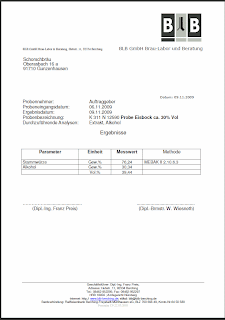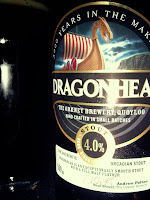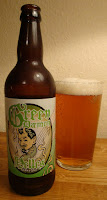
When I was asked to join a group on an annual pub crawl around Münster that they called the Bad Taste Tour, how could I possibly refuse? This particular group of colleagues (I won't reveal where they work) have been doing this for eight years, I believe, so clearly have it down to a fine art. The goal is a crawl of the really bad bars of Münster. Well, some of them at least. The route started near the main train station, then out by bus to a base camp, and then touring back in towards the train station, where, as with pretty much every city, the real scummy bars are. Read on, if you can.
Stop No. 1: Butt's Bierstube,
Hafenstraße 41.The name alone is enough to make an English-speaker snigger, but this is one of those bars I've passed every time I go into the city, and every time I see it I think it looks like a dodgy hole. Part of it is a kebab joint (that seems to have a good reputation!), and the other half is a bar with the kind of brown, opaque windows that suggests that you shouldn't really know what goes on inside. The gang met up at 4:30 last Friday at this location. Due to work commitments, I managed to get in for about 5:30 and grab one beer, a Warsteiner, which was actually like nectar. The bar is cramped, with the island bar taking up most of the room, leaving enough space to squeeze around all sides. On the far side, some regulars sat, a mix of old man with rimmed hat, and young man with baseball cap and bling. I kinda liked the way it seemed multi-generational, but not the way we kept getting stared at. Still, there were 15 of us. Admittedly 14 were wearing Santa hats (not me), so could explain some of the staring.
Stop No. 2: Wesfalen Tankstelle,
Von-Steuben-Straße 13.Yes, a petrol/gas station. Just around the corner from Butt's, the gang descended on the filling station to get a round of shots. Schnapps, Jagermeister and the like. I have to admit I passed on the shots, but you have to admire the fact that you can do such a thing in Germany, and that this group were dead set on keeping the bad taste theme, knocking back the shots on the forecourt.
Stop No. 3: Berliner Bär,
Berliner Platz 30.
Another one of those bars across from the main entrance of the train station that often made me wonder what was in there. Actually, I kind of liked it. There's a pool table, some gaming machines and stand-up tables, nothing fancy. The beer was Iserlohner Pils, which also wasn't going down too badly. We stayed here for two beers before deciding it wasn't really dumpy enough. Even the toilets were clean! One thing though, is it was a smoking bar, like the one before. It felt very odd (and I'm a smoker), but at least with Butt's the place was tiny, so it may have been exempt, or fallen into some loophole, but the Berliner Bär seems like a normal size. Someone said if food isn't served then it can be a smoking bar. Dunno how Butt's gets by then if half the premises is a kebab joint. Oh well, I joined in with gusto.
Stop No. 4: Brinkhoff's Stube, Berliner Platz 14O

k, this is more like it! This is the place that I've passed at 5pm on a Saturday to hear music thumping out of the place and young smokers falling out of the place drunk. That was Summer of course, and just after the smoking restrictions started here. More curtains to keep things shady inside, we walked into a smokey den with white tiled walls and games machines on one side, and a worn bar, with worn swivel chairs attached to the ground, worn, scowling customers, and a worn, robust woman who looked like she'd kick the shit out of you if you made a false move. And you knew she was watching for that move. I reckoned she was waiting for someone to complain about the awful
Schlager musik. The most impressive thing about the place was that they had flies in the toilets even in winter. Oh, and guess what they served? Yeah, Brinkhoff's No. 1. This was going to be a feature of the night. We stayed here for one beer. before hopping across the street to grab the bus out to Wolbecker Straße, and base camp.
Stop No. 5: Aral Tankstelle,
AKA, the Blue Lagoon, AKA Base Camp 1.Yes, another filling station for another top-up of shots of some description. It's funny, really.
 Stop No. 6: Zum Alten Gottfried
Stop No. 6: Zum Alten Gottfried,
Wolbecker Straße 147
This looks like a respectable local pub from the outside, and yeah, it looks nice, if a bit 70's and Spartan inside. With a huge, wide bar, green concrete floor, little tables around the sides, electronic dartboards and a smattering of regulars spaced evenly around the bar. I felt we'd invaded their space a little, but at least we livened it up. The bar woman was made-up to the nines and was perfectly manicured. A man sat across the other side reading his paper and smoking, an old man gave up his seat at the bar for one of the ladies with us, although he said it was because we were too loud for him. Still, he was nice about it. A Bitburger joint, I opted for the Schlösser Alt, and regretted it immediately. It must have been weeks since someone had a glass of it. I may or may not have had a Bitburger here too. Oh, and it was a smoking bar (but I saw they served pre-made sandwiches).
Stop No. 7: Some kiosk on the street for more shots. I didn't have any!
Stop No. 8: Uhrwerk,
Emdener Straße 10.
This stop was a bit off the main street, getting into what felt like a more residential kind of area. I wasn't sure what to expect, but the place was packed with people watching a soccer match, (Bayern Munich vs. Borussia Mönchengladbach as I recall), so there were a few "get out of my fucking face" comments, which were perfectly understandable. I liked this place. The walls are covered in old clocks (the clue is in the name) and old concert posters for the likes of Jimi Hendrix, Tangarine Dream and Bob Dylan. It had a nice feel to it, and I think I could happily sit there with a few beers and a paper or chats. We were served Bitburger here, two to be exact. I know because I took photos.
Stop No. 9: Mütterchen Angsmann,
Wolbecker Straße 64.

We toddled around the corner to Mütterchen Angsmann, another rather nice local bar, for the older generation. Half the group promptly sat down and started playing some dice game, while the other half floated at the bar. There was a good trade in here without us, with nice old dears, and men dressed in red suit jackets with chains of office which were something to do with it being Karnival season here (I even asked if I could take their photo. Well, I asked Michael, the ring-leader, if he'd ask them. Such a bloody tourist!).
It reminded me a little of the local where I grew up in Dublin, in a way. Beers here were Bitburger; two. Strangely, this was also a smoking bar. I just don't get the rules here, or maybe they were just being ignored.
Stop 10: Luig's Bierstube,
Wolbecker Straße 50.
A smallish place, with a pool table and a few tables and worn seating around the place, there were five taps: Brinkhoff's, Brinkhoff's, Brinkhoff's, Brinkhoff's and Brinkhoff's. I chose a Brinkhoff's.
Nothing special about the place. Not a total dump, but not the plushest of places. I had been beginning to complain that the pubs so far were actually pretty ok (with the exception of the first couple perhaps), so I was assured that the next set qould be suitably bad taste. Maybe this was planned to give us a little rest?
Stop 11: Gaststätte Laterne,
Schillerstraße 23.
This is where things definitely took a turn downwards, where the true meaning of Bad Taste Tour came into its own. Clearly, at this stage in the game, I was feeling... well oiled. It was probably just as well, as otherwise I would not have gone into this shithole. It's like a parallel universe. Smokey as hell, I can understand, but the collection of inmates was like something out of a movie. Archetypes all. The sneering, scowling bearded guy in the corners, the group of three merry guys chatting at one end of the bar, the really drunk guy who seemed to be fixed to the bar and who shouted and gesticulated at us the whole time - while being completely ignored by everyone - and the chap who I took a liking to, not only because he looked like one of the Three Musketeers, but also because he just cut such a tragic figure: drunk, and being ignored by everyone, even when he stood at our table and tried engaging. I told you I was well oiled. He started chatting to me in the toilets, I have no idea about what, but he seemed like a nice bloke, with a friendly face. Whatever he was trying to tell me, in mumbled English too (he was from Bayern), part of it was about how he gets ignored, demonstrated by him asking a question of three of my companions, and only getting a response from one, which he was happy with, and resulted in an "I've made my case" gesture. I have to say, I was really curious about what he did, and I began to imagine he was some sort of failed artist. Was sad really.
Oh, Brinkhoff's was on sale here, so I took one.
Stop 12: Leolino's Pilsstube,
Bremer Platz 16,

Look at that exterior. Inviting, isn't it? Looks like chip shop really. On the inside it's all red lights, crap music, and that's all I remember. A photo tells me I was drinking Brinkhoff's No. 1. This is on the street at the back of the train station, where one might expect to find the dodgier establishments. Michael wasn't wrong, although the previous place had set a tone that would be hard to beat.
Stop 13: Brinkhoff's No. 1,
Bremer Platz
You'd think that after all those bloody Brinkhoff's No. 1s that we'd try to avoid a place of the same name (and the second one of that name in one night!). It wasn't to be, as this place was right next door to Leolino's. It wasn't even on the itinerary, so it was a bit of a bonus. A bit. At least the lighting levels were normal, but what a cheerless place. It felt a little rough, but at 1:20am most people were well on and a crowd arriving in (depleted at this point in time) wasn't anything strange. We had the eponymous beer and left for greener pastures, which just happened to be next door.
Stop 14: Bierkanne,
Bremer Platz 6.I don't have photos from inside this place. It would have felt... inappropriate. A strange mix of people, and vaguely threatening, this was confirmed a little later on when one of our companions, who was wearing a green Santa hat was encouraged, shall we say, to give it to a Scottish bloke with a Celtic FC tattoo. I spoke the the Scot later on, and considered asking him to return it (being a "fellow Celt" and all that crap), and concluded he was right to give it to him. A case of let the Wookie win. We stayed long enough to have the Brinkhoff's No. 1 (I have now concluded that any place serving this beer is to be avoided) before trundling to the final destination at about 2am.
Just as we were about to leave, my friend from the Laterne, the Musketeer, arrived in with a leather bag/briefcase. The rest of the guys were ready to move on, but I couldn't resist asking him what it was he did. He started taking folders out of his bag, and I thought I'd been right in my assumption he was an artist. But when he handed my the self-made Christmas card, I was even more saddened. I was right. He was an artist - of sorts. And it wasn't quite a gift. I bought him a beer for the big card with the Christmas tree.
Stop 15: Grille Nacht Cafe,
Bremer Straße 24.
I am now a member of a smoking club.
This place makes you sign a membership card and pay 1 Euro to recognise it's a smoking club that also has a bar and disco. A small, cheesy disco. Check out the photos on their site actually.
This place appears to be legendary, as a former hole that improved, somewhat, to cater for the big student population. It seems like the place of last resort on a night out, and felt like the crappy discos of my youth when out in the sticks.
I didn't really get to look at the place well enough, as soon after ordering a whisky, the Scott arrived. I made the mistake of asking him how he ended up in Germany, when it was clear is was a soldier. The next hour is a blur, as he talked my ear off about stuff I didn't really want to know. At one point he told me I'd put him in a bad mood, which had me worried for a moment, but by the time he left he'd handed me a beer someone else bought for him, and toddled off. The last people of our crew standing gathered together, and we headed homewards. 4am.
I have to say, I have never done a crawl quite like this. Normally it's a crawl of a handful of bars on a party, or crawling bars in a new city in search of nice craft beers. This was something different, and gave me a view of another side of the city I live in. Some quite nice places, and some that I would not go in to alone. Actually, I was quite pleased with myself to have lasted to the end and be part of the final six, but man did I pay for it the next day, and most of the weekend! As Mr. Murtaugh said, I'm getting too old for this shit...
Many thanks to Michael for organising and inviting me on this crazy trip. I still don't know how he does it every year!
 I really like what the Williams Brothers have been doing recently, and used to like the occasional Fraoch, but for some reason, I'd never had their Alba Scots Pine Ale. I picked up a bottle in Amsterdam after TheBeerNut looked pleased at seeing some for sale in the Cracked Kettle, and let's face it, him looking pleased at seeing a beer is usually a good sign. Usually!
I really like what the Williams Brothers have been doing recently, and used to like the occasional Fraoch, but for some reason, I'd never had their Alba Scots Pine Ale. I picked up a bottle in Amsterdam after TheBeerNut looked pleased at seeing some for sale in the Cracked Kettle, and let's face it, him looking pleased at seeing a beer is usually a good sign. Usually!






